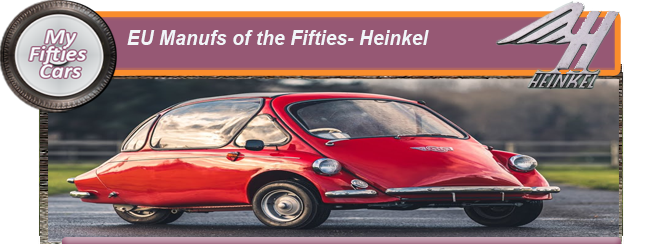 Heinkel was formed by Ernst Heinrich Heinkel in Rostock during the early Nineteen Twenties.
Heinkel enjoyed success and considerable recognition in the years before the outbreak of World War II. Their particular forte was the design, development and production of fighter and bomber aircraft, with almost all of their production going to the German Airforce.
Heinkel was formed by Ernst Heinrich Heinkel in Rostock during the early Nineteen Twenties.
Heinkel enjoyed success and considerable recognition in the years before the outbreak of World War II. Their particular forte was the design, development and production of fighter and bomber aircraft, with almost all of their production going to the German Airforce.
Despite falling out of favour with the Nazis late in the war, Ernst Heinkel was taken into custody by the Allied forces and put on trial for alleged for war crimes.
 Heinkel’s trial lasted a considerable time, but the verdict was inconclusive and he was released after serving a short sentence.
Weakened both financially and morally by the experience it took Heinkel almost five years to reform his company and get back into production.
Heinkel’s trial lasted a considerable time, but the verdict was inconclusive and he was released after serving a short sentence.
Weakened both financially and morally by the experience it took Heinkel almost five years to reform his company and get back into production.
For Heinkel, building aircraft was out of the question. With raw materials in short supply, and gasoline almost impossible to find Heinkel decided to go small.
Heinkel devoted his engineering skills and limited manufacturing facilities towards peace, helping his fellow Germans to improve their ability to get around their war-ravaged country at a low cost.
 Heinkel first began to manufacture bicycles followed up by motorcycles, eventually arriving at the niche of midget automobiles which were becoming increasingly in demand during the Fifties.
Heinkel first began to manufacture bicycles followed up by motorcycles, eventually arriving at the niche of midget automobiles which were becoming increasingly in demand during the Fifties.
 Heinkel titled his new “baby “ the Kabine.
Heinkel titled his new “baby “ the Kabine.
When he was in the business of building aircraft, Heinkel had little need to please the eye, and instead concentrated on such aspects as aerodynamics. He took roughly the same approach with his Kabine, with design inspiration largely drawn for his rivals in the field, Iso and BMW.
![]()
 Powered by a simple two-stroke engine the Kabine was available in a variety of formats among them a delivery van and a pickup truck.
Powered by a simple two-stroke engine the Kabine was available in a variety of formats among them a delivery van and a pickup truck.
In any format the Kabine proved to be an outstanding financial success, selling well in West Germany and the rest of Western Europe, as well as being produced under license in Southern Ireland for the UK market as the Trojan.
The Kabine, like most of its counterparts, had an opening front door - the only access to the interior.
To avoid infringing on Iso's patent, the Kabine’s steering wheel did not hinge outwards with the door, instead staying in place, making getting in and out of the vehicle a challenging process for many.
 Unlike its rival “bubble cars”, the Kabine did have a reverse gear. Another possible plus was that the Kabine If the only door in front became jammed in a collision, the fabric sun roof served as an emergency escape hatch.
Unlike its rival “bubble cars”, the Kabine did have a reverse gear. Another possible plus was that the Kabine If the only door in front became jammed in a collision, the fabric sun roof served as an emergency escape hatch.
 The bubble-shaped windows did make for a comfortable interior providing excellent at visibility in all directions.
The bubble-shaped windows did make for a comfortable interior providing excellent at visibility in all directions.
All of the designs were pretty similar, but some later cars had two wheels next to each other at the back instead of just one. This made them technically four-wheelers.
![]()
All of the three Kabine configurations were powered by a single-cylinder, air-cooled, four-stroke engine with overhead valves.
The original Type 153 cc engined version was capable of generating 9.1 bhp, while the later Type 154 cars had their engines tweaked so they could generate 9.9 bhp.
 Later came a 174cc engined version as well as a 204cc engined Kabine, all of them more or less identical in appearance.
Unlike most microcars, the Kabine came fitted with a four-speed transmission including a reverse gear, which made it much easier for its owners to park.
Later came a 174cc engined version as well as a 204cc engined Kabine, all of them more or less identical in appearance.
Unlike most microcars, the Kabine came fitted with a four-speed transmission including a reverse gear, which made it much easier for its owners to park.
By the end of the Fifties, restrictions were lifted on all of the West German who produced aircraft during World War 2, on condition that they were only involved in producing commercial aircraft.
Heinkel gradually took to the skies again, discontinuing production of the Kabine in the process, although they did continue to produce scooters until the mid-Sixties.
 Heinrich Heinkel was, unfortunately, not around to see his company return to aircraft production as he passed away in 1958, just as the process got under way.
Heinrich Heinkel was, unfortunately, not around to see his company return to aircraft production as he passed away in 1958, just as the process got under way.
Without Heinrich at the controls, Heinkel lost their direction and began to change hands regularly over the next few decades, until eventually swallowed up as part of the massive European Airbus project.
Few Heinkel Kabine cars have made it to the present day.

